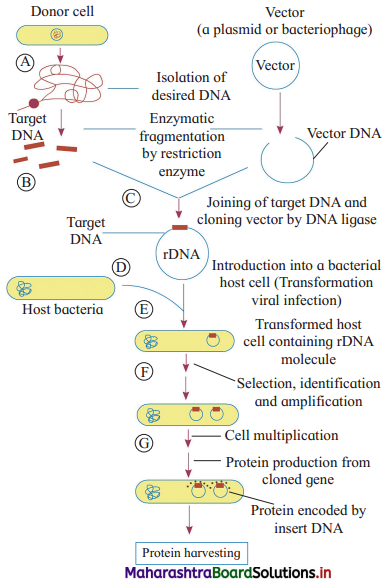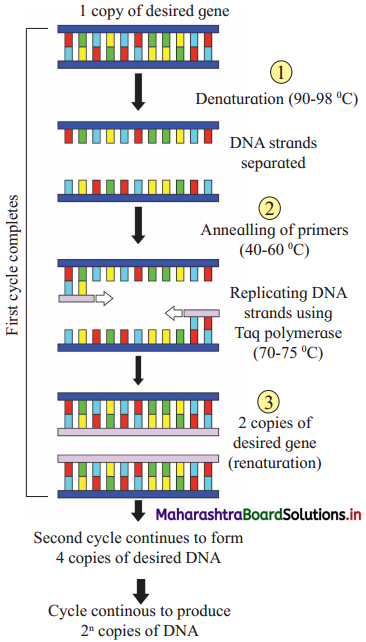Balbharti Maharashtra State Board 12th Biology Textbook Solutions
Chapter 12 Biotechnology Textbook Exercise Questions and Answers.
1. Multiple choice questions
Question 1.
MU The bacterium which causes a plant disease called crown gall is ………………..
(a) Helicobacter pylori
(b) Agrobacterium tumifaciens
(c) Thermophilus aquaticus
(d) Bacillus thuringienesis
Answer:
(b) Agrobacterium tumtfaciens
Question 2.
The enzyme nuclease hydrolyses ……………….. of polynucleotide chain of DNA.
(a) hydrogen bonds
(b) phosphodiester bonds
(c) glycosidic bonds
(d) peptide bonds
Answer:
(b) phosphodiester bonds

Question 3.
In vitro amplification of DNA or RNA segment is known as ………………..
(a) chromatography
(b) southern blotting
(c) polymerase chain reaction
(d) gel electrophoresis
Answer:
(c) polymerase chain reaction
Question 4.
Which of the following is the correct recognition sequence of restriction enzyme hind III.
(a) 5′ —A-A-G-C-T-T— 3′
3′ —T-T-C-G-A-A—5′
(b) 5′ — G-A-A-T-T-C—3′
3′ — C-T-T-A-A-G—5′
(c) 5′ — C-G-A-T-T-C—3′
3′ — G-C-T-A-A-G—5′
(d) 5′ — G-G-C-C—3′
3′ — C-C-G-G—5′
Answer:
(a) 5’ —A-A-G-C-T-T—3’
3’ —T-T-C-G-A-A—5’
Question 5.
Recombinant protein ……………….. is used to dissolve blood clots present in the body.
(a) insulin
(b) tissue plasminogen activator
(c) relaxin
(d) erythropoietin
Answer:
(b) tissue plasminogen activator
Question 6.
Recognition sequence of restriction enzymes are generally ……………….. nucleotide long.
(a) 2 to 4
(b) 4 to 8
(c) 8 to 10
(d) 14 to 18
Answer:
(b) 4 to 8
2. Very short answer questions
Question 1.
Name the vector which is used in production of human insulin through recombinant DNA technology.
Answer:
PBR 322
Question 2.
Which cells from Langerhans of pancreas do produce a peptide hormone insulin?
Answer:
cells of islets of Langerhans of a peptide hormone insulin.
Question 3.
Give the role of Ca++ ions in the transfer of recombinant vector into bacterial host cell.
Answer:
Ca++ ions promotes binding of plasmid DNA to lipo polysaccharides on bacterial cell surface. Then plasmid can enter the cell on heat shock.
Question 4.
Expand the following acronyms which are used in the held of biotechnology:
Answer:
Question 5.
Fill in the blanks and complete the chart.
Answer:

3. Short answer type questions.
Question 1.
Explain the properties of a good or ideal cloning vector for r-DNA technology.
Answer:
Desired characteristics of ideal cloning vector are as follows:
Question 2.
A PCR machine can rise temperature up to 100 °C but after that it is not able to lower the temperature below 70 °C automatically. Which step of PCR will be hampered first in this faulty machine? Explain why?
Answer:
Question 3.
In the process of r-DNA technology, if two separate restriction enzymes are used to cut vector and donor DNA then which problem will arise in the formation of r-DNA or chimeric DNA? Explain.
Answer:
In the process of r-DNA technology, if two separate restriction enzymes are used to cut vector and donor DNA, then it will result in fragments with different sticky ends which will not be complementary to each other.
Question 4.
Answer:
4. Long answer type questions.
Question 1.
(i) Define and explain the terms Bioethics.
Answer:
Ethical aspects pertaining to the use of biotechnology are:

(ii) Define and explain the term Biopiracy.
Answer:
Following are the examples of biopiracy:
(a) Patenting of Neem (Azadirachta indica):
(b) Patenting of Basmati:
(c) Haldi (Turmeric) Biopiracy:
(iii) Define and explain the term Biopatent.
Answer:
This patent was not granted by Indian government. Such a patent is considered morally unacceptable and fundamentally unequitable. Such patents would pose a threat to global food security as financially powerful corporations would acquire monopoly over biotechnological process.
Question 2.
Explain the steps in process of r-DNA technology with suitable diagrams.
Answer:

The steps involved in gene cloning are as follows:
(1) Isolation of DNA (gene) from the donor organism:
(2) Insertion of desired foreign gene into a cloning vector (vehicle DNA):
(3) Transfer of r-DNA into suitable competent host or cloning organism:

(4) Selection of the transformed host cell:
(5) Multiplication of transformed host cell:
(6) Expression of gene to obtain desired product. Then desired products like enzymes, antibiotiocs etc. separated and purified through down stream processing using bioreactors.
Question 3.
Explain the gene therapy. Give two types of it.
Answer:
Gene therapy is the treatment of genetic disorders by replacing, altering or supplementing a gene that is absent or abnormal and whose absence or abnormality is responsible for the disease.
Types of gene therapy:
(a) Germ line gene therapy:
(b) Somatic cell gene therapy:
Question 4.
How are the transgenic mice used in cancer research?
Answer:
Question 5.
Give the steps in PCR or polymerase chain reaction with suitable diagrams.
Answer:

(1) The DNA segment and excess of two primer molecules, four types of dNTPs, the thermostable DNA polymerase are mixed together in ‘eppendorf tube’.
(2) One PCR cycle is of 3-4 minutes duration and it involves following steps:
(3) In an automatic thermal cycler, the above three steps are automatically repeated 20-30 times.
(4) Thus, at the end of ‘n’ cycles 2n copies of DNA segments, get synthesized.
Question 6.
What is a vaccine? Give advantages of oral vaccines or edible vaccines.
Answer:
Question 7.
Enlist different types of restriction enzymes commonly used in r-DNA technology? Write on their role.
Answer:

Question 8.
Enlist and write in brief about the different biological tools required in r-DNA technology.
Answer:
The biological tools used in r-DNA technology are various enzymes, cloning vectors and competent hosts.
(1) Enzymes:
(2) Vectors:
(3) Competent host cells:
Chapter 12 Biotechnology Textbook Exercise Questions and Answers.
1. Multiple choice questions
Question 1.
MU The bacterium which causes a plant disease called crown gall is ………………..
(a) Helicobacter pylori
(b) Agrobacterium tumifaciens
(c) Thermophilus aquaticus
(d) Bacillus thuringienesis
Answer:
(b) Agrobacterium tumtfaciens
Question 2.
The enzyme nuclease hydrolyses ……………….. of polynucleotide chain of DNA.
(a) hydrogen bonds
(b) phosphodiester bonds
(c) glycosidic bonds
(d) peptide bonds
Answer:
(b) phosphodiester bonds

Question 3.
In vitro amplification of DNA or RNA segment is known as ………………..
(a) chromatography
(b) southern blotting
(c) polymerase chain reaction
(d) gel electrophoresis
Answer:
(c) polymerase chain reaction
Question 4.
Which of the following is the correct recognition sequence of restriction enzyme hind III.
(a) 5′ —A-A-G-C-T-T— 3′
3′ —T-T-C-G-A-A—5′
(b) 5′ — G-A-A-T-T-C—3′
3′ — C-T-T-A-A-G—5′
(c) 5′ — C-G-A-T-T-C—3′
3′ — G-C-T-A-A-G—5′
(d) 5′ — G-G-C-C—3′
3′ — C-C-G-G—5′
Answer:
(a) 5’ —A-A-G-C-T-T—3’
3’ —T-T-C-G-A-A—5’
Question 5.
Recombinant protein ……………….. is used to dissolve blood clots present in the body.
(a) insulin
(b) tissue plasminogen activator
(c) relaxin
(d) erythropoietin
Answer:
(b) tissue plasminogen activator
Question 6.
Recognition sequence of restriction enzymes are generally ……………….. nucleotide long.
(a) 2 to 4
(b) 4 to 8
(c) 8 to 10
(d) 14 to 18
Answer:
(b) 4 to 8
2. Very short answer questions
Question 1.
Name the vector which is used in production of human insulin through recombinant DNA technology.
Answer:
PBR 322
Question 2.
Which cells from Langerhans of pancreas do produce a peptide hormone insulin?
Answer:
cells of islets of Langerhans of a peptide hormone insulin.
Question 3.
Give the role of Ca++ ions in the transfer of recombinant vector into bacterial host cell.
Answer:
Ca++ ions promotes binding of plasmid DNA to lipo polysaccharides on bacterial cell surface. Then plasmid can enter the cell on heat shock.
Question 4.
Expand the following acronyms which are used in the held of biotechnology:
Answer:
Question 5.
Fill in the blanks and complete the chart.
| GMO | Purpose |
| (i) Bt cotton | ———– |
| (ii) ———- | Delay the softening of tomato during ripening |
| (iii) Golden rice | ———– |
| (iv) Holstein cow | ———– |
| GMO | Purpose |
| (i) Bt cotton | Insect resistance |
| (ii) Flavr savr Tomato | Delay the softening of tomato during ripening |
| (iii) Golden rice | Rich in vitamin A |
| (iv) Holstein cow | High milk productivity |

3. Short answer type questions.
Question 1.
Explain the properties of a good or ideal cloning vector for r-DNA technology.
Answer:
Desired characteristics of ideal cloning vector are as follows:
Question 2.
A PCR machine can rise temperature up to 100 °C but after that it is not able to lower the temperature below 70 °C automatically. Which step of PCR will be hampered first in this faulty machine? Explain why?
Answer:
Question 3.
In the process of r-DNA technology, if two separate restriction enzymes are used to cut vector and donor DNA then which problem will arise in the formation of r-DNA or chimeric DNA? Explain.
Answer:
In the process of r-DNA technology, if two separate restriction enzymes are used to cut vector and donor DNA, then it will result in fragments with different sticky ends which will not be complementary to each other.
Question 4.
| Recombinent protein | Its use in or for |
| (1) Platelet derived growth factor | (a) Anemia |
| (2) a-antitrypsin | (b) Cystic fibrosis |
| (3) Relaxin | (c) Haemophilia A |
| (4) Eryhthropoietin | (d) Diabetes |
| (5) Factor VIII | (e) Emphysema |
| (6) DNA ase | (f) Parturition |
| (g) Atherosclerosis |
| Recombinent protein | Its use in or for |
| (1) Platelet derived growth factor | (g) Atherosclerosis |
| (2) a-antitrypsin | (e) Emphysema |
| (3) Relaxin | (f) Parturition |
| (4) Eryhthropoietin | (a) Anemia |
| (5) Factor VIII | (c) Haemophilia A |
| (6) DNA ase | (b) Cystic fibrosis |
Question 1.
(i) Define and explain the terms Bioethics.
Answer:
Ethical aspects pertaining to the use of biotechnology are:

(ii) Define and explain the term Biopiracy.
Answer:
Following are the examples of biopiracy:
(a) Patenting of Neem (Azadirachta indica):
(b) Patenting of Basmati:
(c) Haldi (Turmeric) Biopiracy:
(iii) Define and explain the term Biopatent.
Answer:
This patent was not granted by Indian government. Such a patent is considered morally unacceptable and fundamentally unequitable. Such patents would pose a threat to global food security as financially powerful corporations would acquire monopoly over biotechnological process.
Question 2.
Explain the steps in process of r-DNA technology with suitable diagrams.
Answer:

The steps involved in gene cloning are as follows:
(1) Isolation of DNA (gene) from the donor organism:
(2) Insertion of desired foreign gene into a cloning vector (vehicle DNA):
(3) Transfer of r-DNA into suitable competent host or cloning organism:

(4) Selection of the transformed host cell:
(5) Multiplication of transformed host cell:
(6) Expression of gene to obtain desired product. Then desired products like enzymes, antibiotiocs etc. separated and purified through down stream processing using bioreactors.
Question 3.
Explain the gene therapy. Give two types of it.
Answer:
Gene therapy is the treatment of genetic disorders by replacing, altering or supplementing a gene that is absent or abnormal and whose absence or abnormality is responsible for the disease.
Types of gene therapy:
(a) Germ line gene therapy:
(b) Somatic cell gene therapy:
Question 4.
How are the transgenic mice used in cancer research?
Answer:
Question 5.
Give the steps in PCR or polymerase chain reaction with suitable diagrams.
Answer:

(1) The DNA segment and excess of two primer molecules, four types of dNTPs, the thermostable DNA polymerase are mixed together in ‘eppendorf tube’.
(2) One PCR cycle is of 3-4 minutes duration and it involves following steps:
(3) In an automatic thermal cycler, the above three steps are automatically repeated 20-30 times.
(4) Thus, at the end of ‘n’ cycles 2n copies of DNA segments, get synthesized.
Question 6.
What is a vaccine? Give advantages of oral vaccines or edible vaccines.
Answer:
Question 7.
Enlist different types of restriction enzymes commonly used in r-DNA technology? Write on their role.
Answer:

Question 8.
Enlist and write in brief about the different biological tools required in r-DNA technology.
Answer:
The biological tools used in r-DNA technology are various enzymes, cloning vectors and competent hosts.
(1) Enzymes:
(2) Vectors:
(3) Competent host cells: